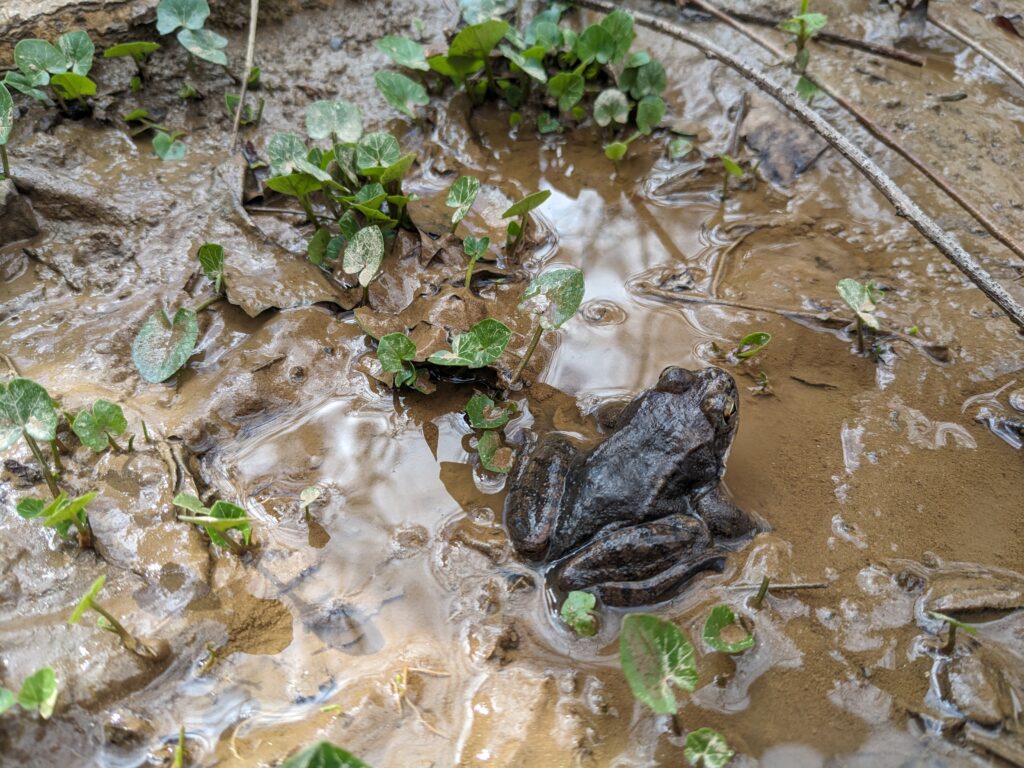Because NeighborSpace’s conservation goals address both social and environmental needs, each of our sites provides a space for humans to connect with each other and with nature while also providing habitat for local wildlife. Some of our sites, however, are especially valuable because they provide habitat to sensitive species and are important for local water quality.
Per the US Department of Agriculture, a riparian forest buffer is “an area adjacent to a stream, lake, or wetland that contains a combination of trees, shrubs, and/or other perennial plants and is managed differently from the surrounding landscape, primarily to provide conservation benefits”. Such buffers can help meet a number of natural resource, economic, and social objectives, including: filtering nutrients and sediment from stormwater runoff; providing shade, shelter and food for aquatic organisms; providing wildlife habitat and corridors for terrestrial organisms; protecting downstream communities from flood damage; and creating recreational spaces. Several NeighborSpace sites serve as riparian forest buffers, but three of them are traversed both by a stream and heavily used walking paths: Levickas Woods in Catonsville, Tollgate Wyndham Preserve in Owings Mills, and Volz Neighborhood Park in Middle River.



These three sites are the focus of a new project that NeighborSpace is hoping to roll out within the next year. The goal of the project is twofold: (1) perform targeted restoration and measurably improve the riparian habitat; and (2) build community capacity to sustainably monitor and steward the sites in the future. This will be accomplished through a mix of educational activities, citizen science, professional invasive removal, volunteer stream clean-ups and the planting of native trees, shrubs and perennials.
In order to ensure that restoration efforts are effectively addressing local habitat needs and to raise awareness of the importance of keeping NeighborSpace sites clean and healthy, we first need to know who calls these spaces home. Amphibians, in particular, are good indicators of significant environmental changes. Since amphibians breathe at least partly through their skin, their bodies are much more sensitive to environmental factors such as pollution and habitat destruction than those of other classes of animals. They also need water to reproduce. Amphibian populations are severely declining worldwide, for a number of reasons, and so there is an urgent need to protect and restore what habitat we can. A critical habitat component for several native amphibian species is the presence of temporary ponds in the spring, on which they rely for the reproduction and development of their young. Such “vernal pools” are typically small, ephemeral water bodies that have no permanent inlet or outlet: they fill each spring with rain and snow melt, then dry up for a period of time during the summer. Interestingly, the PA Natural Heritage Program cites that 85% of vernal pool amphibians return each year to breed in the pond where they were born, emphasizing the importance of preserving these sites. Vernal pools can be found at each of the three NeighborSpace parks listed above as well as at several others.
NeighborSpace is excited to partner with the Herpetology Club at the Natural History Society of Maryland to begin surveying its sites. Herpetology Club members and NeighborSpace staff have already visited Sawmill Preserve and Tollgate Wyndham Preserve, and visits to Volz Neighborhood Park and our Norman Creek site in Essex are scheduled for the next few weeks. These first visits are focused on finding and identifying as many species as possible; more detailed population surveys will be performed in the future. Despite the early March cold, the Club found snails and snail eggs, red-backed salamanders and eggs, and a male wood frog thawing out from his winter dormancy. Wood frogs are extremely cold-resistant and can tolerate up to 65% of their body water freezing! They are also reliant on vernal pools for reproduction.





Aside from the project sketched above, the work of collecting and tracking data on animal and plant species present at NeighborSpace sites is an important strategy in achieving the organization’s vision for a network of highly effective sites and volunteers. As highlighted in NeighborSpace’s 5-year Strategic Plan, we are focused on performing effective restoration and developing a sustainable stewardship model. While NeighborSpace’s custom GIS tool and anecdotal evidence show that its sites are addressing local environmental and social needs, regular collection of data on a consistent set of metrics will allow us to better measure their impact and adjust stewardship efforts accordingly.
NeighborSpace is grateful to the Herpetology Club members for sharing their expertise and time with us. We hope to open up a surveying session to the public in the future. In the meantime, check out the Natural History Society of Maryland’s many offerings and NeighborSpace’s busy spring calendar.